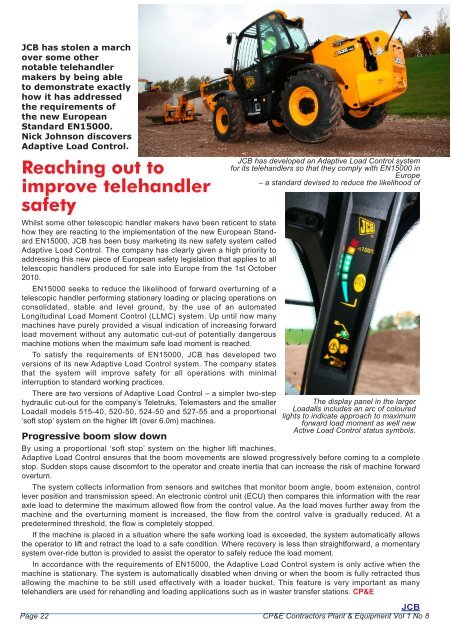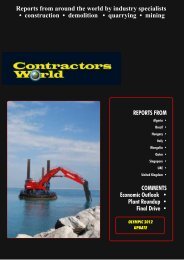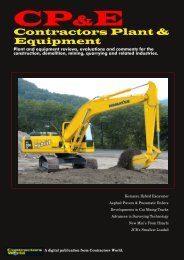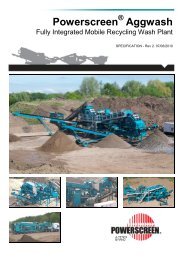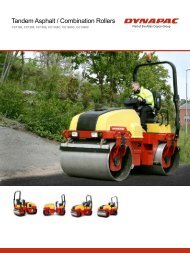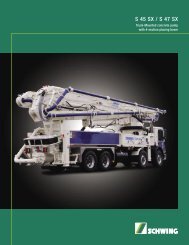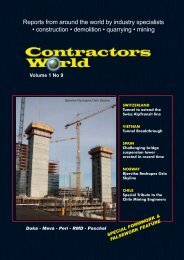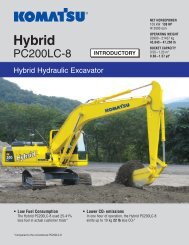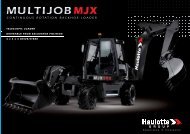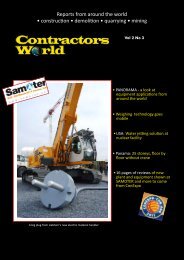download pdf version - Contractors World
download pdf version - Contractors World
download pdf version - Contractors World
Create successful ePaper yourself
Turn your PDF publications into a flip-book with our unique Google optimized e-Paper software.
JCB has stolen a march<br />
over some other<br />
notable telehandler<br />
makers by being able<br />
to demonstrate exactly<br />
how it has addressed<br />
the requirements of<br />
the new European<br />
Standard EN15000.<br />
Nick Johnson discovers<br />
Adaptive Load Control.<br />
Reaching out to<br />
improve telehandler<br />
safety<br />
Whilst some other telescopic handler makers have been reticent to state<br />
how they are reacting to the implementation of the new European Standard<br />
EN15000, JCB has been busy marketing its new safety system called<br />
Adaptive Load Control. The company has clearly given a high priority to<br />
addressing this new piece of European safety legislation that applies to all<br />
telescopic handlers produced for sale into Europe from the 1st October<br />
2010.<br />
EN15000 seeks to reduce the likelihood of forward overturning of a<br />
telescopic handler performing stationary loading or placing operations on<br />
consolidated, stable and level ground, by the use of an automated<br />
Longitudinal Load Moment Control (LLMC) system. Up until now many<br />
machines have purely provided a visual indication of increasing forward<br />
load movement without any automatic cut-out of potentially dangerous<br />
machine motions when the maximum safe load moment is reached.<br />
To satisfy the requirements of EN15000, JCB has developed two<br />
<strong>version</strong>s of its new Adaptive Load Control system. The company states<br />
that the system will improve safety for all operations with minimal<br />
interruption to standard working practices.<br />
There are two <strong>version</strong>s of Adaptive Load Control – a simpler two-step<br />
hydraulic cut-out for the company’s Teletruks, Telemasters and the smaller<br />
Loadall models 515-40, 520-50, 524-50 and 527-55 and a proportional<br />
‘soft stop’ system on the higher lift (over 6.0m) machines.<br />
Progressive boom slow down<br />
JCB has developed an Adaptive Load Control system<br />
for its telehandlers so that they comply with EN15000 in<br />
Europe<br />
– a standard devised to reduce the likelihood of<br />
The display panel in the larger<br />
Loadalls includes an arc of coloured<br />
lights to indicate approach to maximum<br />
forward load moment as well new<br />
Active Load Control status symbols.<br />
By using a proportional ‘soft stop’ system on the higher lift machines,<br />
Adaptive Load Control ensures that the boom movements are slowed progressively before coming to a complete<br />
stop. Sudden stops cause discomfort to the operator and create inertia that can increase the risk of machine forward<br />
overturn.<br />
The system collects information from sensors and switches that monitor boom angle, boom extension, control<br />
lever position and transmission speed. An electronic control unit (ECU) then compares this information with the rear<br />
axle load to determine the maximum allowed flow from the control value. As the load moves further away from the<br />
machine and the overturning moment is increased, the flow from the control valve is gradually reduced. At a<br />
predetermined threshold, the flow is completely stopped.<br />
If the machine is placed in a situation where the safe working load is exceeded, the system automatically allows<br />
the operator to lift and retract the load to a safe condition. Where recovery is less than straightforward, a momentary<br />
system over-ride button is provided to assist the operator to safely reduce the load moment.<br />
In accordance with the requirements of EN15000, the Adaptive Load Control system is only active when the<br />
machine is stationary. The system is automatically disabled when driving or when the boom is fully retracted thus<br />
allowing the machine to be still used effectively with a loader bucket. This feature is very important as many<br />
telehandlers are used for rehandling and loading applications such as in waster transfer stations. CP&E<br />
JCB<br />
Page 22 CP&E <strong>Contractors</strong> Plant & Equipment Vol 1 No 8


